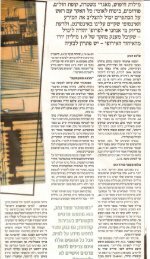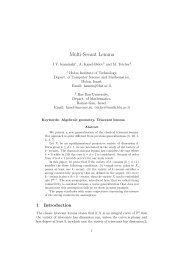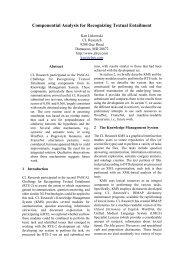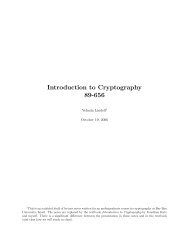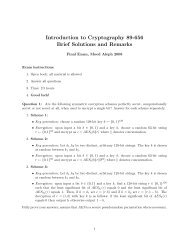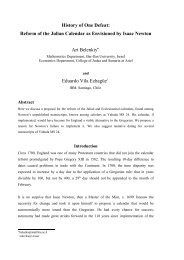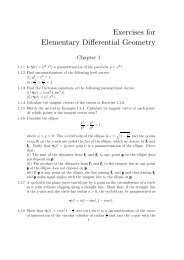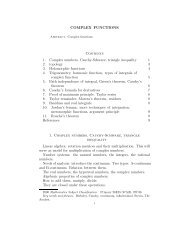Resolving Uncertainty: A Unified Overview of Rabbinic Methods
Resolving Uncertainty: A Unified Overview of Rabbinic Methods
Resolving Uncertainty: A Unified Overview of Rabbinic Methods
Create successful ePaper yourself
Turn your PDF publications into a flip-book with our unique Google optimized e-Paper software.
Sfek Sfeka<br />
Not every case in which both RDIK and RDLK fail necessarily results in two<br />
possibilities. Recall that in our comparison <strong>of</strong> RDIK with the classical interpretation<br />
<strong>of</strong> probability above, there was a glaring gap. The sample spaces in RDIK were<br />
limited to concrete objects in a set. What happens when an object is not drawn from a<br />
set <strong>of</strong> objects in some proportion (so that RDIK in the usual sense does not apply),<br />
but there are more than two possibilities for assigning its status. Does there exist<br />
some extension <strong>of</strong> RDIK to such abstract sample spaces? According to one opinion,<br />
sfek sfeka is just such an extension.<br />
The principle <strong>of</strong> sfek sfeka is this: If a particular prohibition holds only if both<br />
conditions A and B hold, and in fact both A and B are in doubt, then we can assume<br />
that the prohibition does not hold. Rashba (Resp. 1:401) states that sfek sfeka operates<br />
"like a rov". There are two main branches <strong>of</strong> thought regarding the nature <strong>of</strong> this<br />
analogy. According to one approach, sfek sfeka is like rov in its effect but not in its<br />
mechanics. Thus according to Ra'ah (Bedek haBayit on Torat haBayit 4:2, p. 235 in the<br />
Mossad haRav Kook edition) the principle <strong>of</strong> sfek sfeka may simply arise naturally<br />
from the iterative application <strong>of</strong> the rules for handling a single safek; the first safek<br />
reduces the issur to a derabanan and the second renders it permitted (see also Shaarei<br />
Yosher 1:19). A related interpretation, ascribed to R. Yosef Dov Soloveichik , is that we<br />
regard a safek between permitted and only possibly forbidden as if there is no leidat<br />
hasafek. Consequently, even in instances <strong>of</strong> sfek sfeka in which it might be possible to<br />
ascertain the actual facts, one is not obliged to make a special effort to do so (Rosh on<br />
Avodah Zarah, Perek Ein Ma'amidin, Para. 35 and Ramo YD 110:9). Understood this<br />
way, sfek sfeka has the effect <strong>of</strong> one type <strong>of</strong> RDLK: in each, there is no leidat hasafek.<br />
A second approach to sfek sfeka, the one <strong>of</strong> primary interest for our purposes, extends<br />
the analogy to rov to include the mechanism through which sfek sfeka works. Thus R.<br />
Y. S. Natanzon (Resp. Shoel Umeishiv 1:196 and many other places) elaborates that<br />
sfek sfeka can be thought <strong>of</strong> as an extension <strong>of</strong> the idea <strong>of</strong> RDIK in which the sample<br />
space consists <strong>of</strong> the set <strong>of</strong> possible truth assignments to the various individual<br />
conditions 19 . For example, a newlywed woman who is found to have had sexual<br />
19<br />
One disadvantage <strong>of</strong> this approach is that sometimes the phrase sfek sfeka is used with regard to a<br />
mixed set which then falls into another set (for example, Zevachim 74a). According to this second<br />
interpretation <strong>of</strong> sfek sfeka, the overlap in terminology is misleading and such mixture within mixture<br />
cases must be analyzed in the context <strong>of</strong> the rules governing mixed sets discussed above. According to<br />
the first approach, the conflation <strong>of</strong> ordinary kinds <strong>of</strong> sfek sfeka and mixtures within mixtures makes<br />
sense: in each the "outer" safek/mixture is treated leniently because the chamur side fails to satisfy the<br />
requirement <strong>of</strong> itchazek issura (see the discussion near footnote 12 above ).



